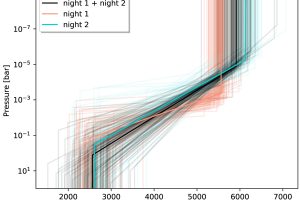Thermal inversion in the atmosphere of Hot Jupiters. The study: “The GAPS Programme at TNG. XXXIII. HARPS-N detects multiple atomic species in emission from the dayside of KELT-20b” of F. Borsa (INAF – OA Brera) recently appeared on A&A

Thermal inversion is a common phenomenon on Earth’s atmosphere. It occurs when temperature does stop decreasing with increasing height, typically because of layers of warm air flowing upon cold air close to the ground. On Earth, this phenomenon plays an important role in the formation of clouds and precipitation.
Thermal inversion is important also for a peculiar class of exoplanets: the Hot Jupiters. These gaseous giants orbit very close to their parent stars (less than 0.1 Astronomical Unit, A.U., where 1 A.U. corresponds to 150 million km, which is the mean Earth-Sun distance), intercepting a large amount of radiation emitted by the star. For this reason, their upper atmospheres can be heated up to more than 2000 K. In the last decade, it has been suggested that thermal inversion in hot Jupiters atmospheres occurs at a local temperature of about 1700 K, mainly because of the stellar radiation absorbed by molecules of TiO (titanium oxide), VO (vanadium oxide), and H2O (water).
The chemistry of the exoplanets atmospheres is studied by means of spectroscopic observations at high spectral resolution of transiting systems, which are systems in which the planets transit in front of their stars along our line of sight during the orbit. Such observations are provided, for instance, by the GAPS (Global Architecture of Planetary Systems) project. This survey is based on observations made with the spectrograph HARPS-N, mounted at the Telescopio Nazionale Galileo. The main objective of GAPS is to study the architecture of explanetary systems and to perform detailed chemical studies of planets atmosphere.
The team led by the astronomer F. Borsa (INAF – Astronomical Observatory of Brera) has analyzed the GAPS observations of the exoplanet KELT-20, a hot Jupiter orbiting around a A2 star with an orbital period of 3.5 days, with the aim of understanding how and if thermal inversion occurs in its atmosphere. KELT-20 has already been the subject of several studies, which have identified in its atmosphere the presence of sodium, hydrogen, iron, calcium, and chromium. Once the planetary spectrum was isolated from the stellar one, the team has identified the signature indicating the presence of iron, both neutral and ionized, and chromium. Then, it was possible to apply complicated statistical methods aimed at comparing the observed spectra with those synthetized from atmospheric models, in order to derive the temperature vs. pression profile of the atmosphere of KELT-20. This analysis confirmed the presence of thermal inversion in the atmosphere of the planet due to the absorpriont of stellar UV radiation by molecules of heavy elements in the upper atmospheric layers. Besides, the intensity of some of these signals seems to depend on the orbital planetary phase: while neutral iron was observed at any phase, ionized iron and chromium’s signals were more evident after planet occultation, e.g. after the planet passed behind the star along our line of sight, showing to us the hottest part of its atmosphere. The study is described in the paper: “The GAPS Programme at TNG. XXXIII. HARPS-N detects multiple atomic species in emission from the dayside of KELT-20b“, recently appeared on Astronomy & Astrophysics. S. Benatti, astronomer of INAF – Astronomical Observatory of Palermo, is among the coauthors.
The figure (clik here to visualize the entire image) shows the temperature vs. pression profile for the atmosphere of KEL-20. The innermost atmospheric layers are downward in the graph, corresponding to higher pression values. The various lines represent profiles obtained from specific observations, while the black line is obtained from the whole set of data. The thermal inversion occurs in those layers where temperature rises at decreasing pression.
Mario Giuseppe Guarcello ( follow mguarce) ( youtube)
Follow the Astronomical Observatory of Palermo on Facebok
Subscribe the Youtube channel of the Astronomical Observatory of Palermo
